Geography Playlist
19 chapters • 0 completed
The Universe and the Earth
18 topics
Atmosphere and its composition
6 topics
Atmospheric Temperature
11 topics
Atmospheric Moisture
9 topics
Air Mass, Fronts & Cyclones
15 topics
Evolution of Earths Crust, Earthquakes and Volcanoes
23 topics
Interior of The Earth
14 topics
Landforms
25 topics
Geomorphic Processes
10 topics
Movement of Ocean Water
16 topics
Oceans and its Properties
12 topics
Climate of a Region
14 topics
Indian Geography - introduction, Geology
5 topics
Physiography of India
27 topics
Indian Climate
20 topics
Indian Drainage
32 topics
Soil and Natural Vegetation
13 topics
Mineral and Energy Resources, Industries in India
28 topics
Indian Agriculture
22 topics
Chapter 16: Indian Drainage
Chapter TestDrainage System in India
The drainage system refers to the flow of water through well-defined channels forming a network. Indian rivers exhibit diverse drainage patterns based on landform evolution, rock structure, and geological history.
The drainage system refers to the flow of water through well-defined channels forming a network. Indian rivers exhibit diverse drainage patterns based on landform evolution, rock structure, and geological history.
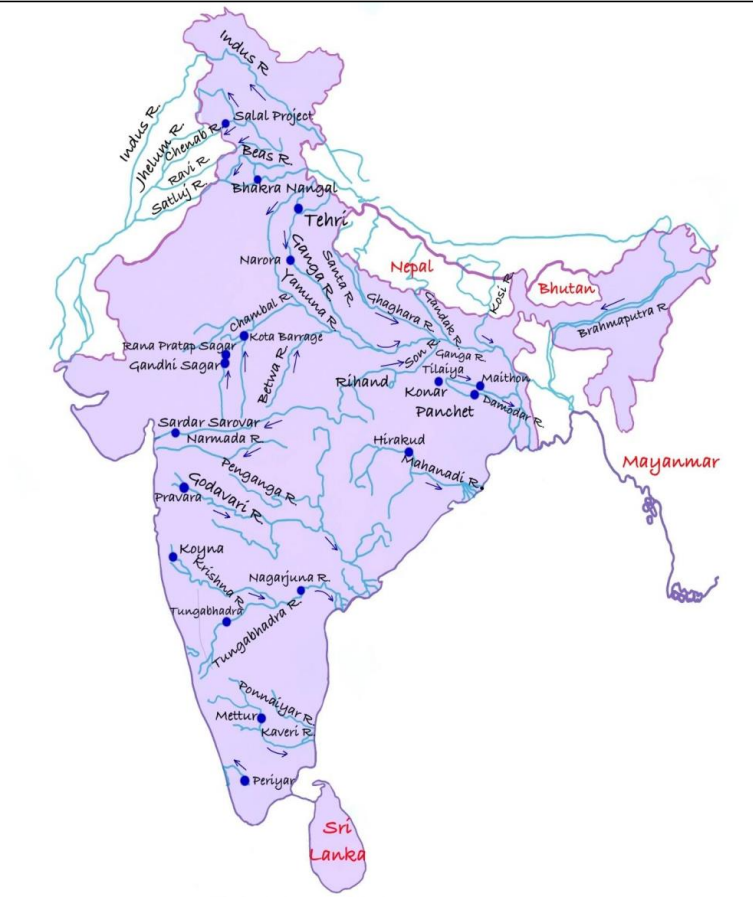
Types of Drainage Systems – Key Features
| Type | Description | Examples |
|---|---|---|
| Consequent | Follows natural slope of land | Godavari, Kaveri |
| Sequent | Formed after consequent, usually tributaries | Yamuna |
| Subsequent | Erosion of softer rocks after main rivers | Parallel streams |
| Obsequent | Flow opposite to main river | Tributaries of Ganga (Siwalik) |
| Resequent | Later streams, same direction as main river | Minor tributaries |
| Insequent | Random pattern, no structural control | Plateau streams |
| Antecedent | Older than land uplift, maintain course | Indus, Sutlej, Brahmaputra |
| Superimposed | Cut across rocks regardless of structure | Damodar, Subarnarekha, Chambal |
Mains Key Points
Prelims Strategy Tips
Drainage Patterns and Classification of Indian Drainage
India’s drainage system is shaped by physiography, slope, rock structure, and climatic conditions. Major patterns include dendritic, trellis, rectangular, radial, parallel, and centripetal. Drainage is classified based on orientation (Bay of Bengal vs Arabian Sea), origin (Himalayan vs Peninsular), and type (sea-draining vs inland). This system sustains agriculture, water supply, hydropower, and ecosystems.
India’s drainage system is shaped by physiography, slope, rock structure, and climatic conditions. Major patterns include dendritic, trellis, rectangular, radial, parallel, and centripetal. Drainage is classified based on orientation (Bay of Bengal vs Arabian Sea), origin (Himalayan vs Peninsular), and type (sea-draining vs inland). This system sustains agriculture, water supply, hydropower, and ecosystems.
Drainage Orientation in India
| System | Drainage Area | Discharge | Major Rivers |
|---|---|---|---|
| Bay of Bengal | 77% of India | 90% discharge | Ganga, Brahmaputra, Godavari, Krishna, Cauvery |
| Arabian Sea | 23% of India | 10% discharge | Narmada, Tapti, Sabarmati, Mahi |
Mains Key Points
Prelims Strategy Tips
Himalayan River System
The Himalayan Rivers originate from glaciers of the Hindu-Kush Himalaya, often called the 'Third Pole'. These rivers are perennial, fed by melting snow, rainfall, and groundwater, and are older than the Himalayas themselves, as shown by the deep antecedent gorges they cut through.
The Himalayan Rivers originate from glaciers of the Hindu-Kush Himalaya, often called the 'Third Pole'. These rivers are perennial, fed by melting snow, rainfall, and groundwater, and are older than the Himalayas themselves, as shown by the deep antecedent gorges they cut through.
Comparison of Major Himalayan River Systems
| River System | Origin | Length | Major Tributaries | Outflow |
|---|---|---|---|---|
| Indus | Lake Manasarovar, Tibet | 2900 km | Jhelum, Chenab, Ravi, Beas, Sutlej | Arabian Sea |
| Ganga | Gangotri Glacier (Bhagirathi) + Alaknanda | 2525 km | Yamuna, Ghaghara, Gandak, Kosi, Son | Bay of Bengal (Sundarbans Delta) |
| Brahmaputra | Chemayungdung Glacier, Tibet (Tsangpo) | 2900 km (916 km in India) | Subansiri, Manas, Teesta, Lohit, Dibang | Bay of Bengal (as Jamuna in Bangladesh) |
Mains Key Points
Prelims Strategy Tips
Indus River System
The Indus is one of the world's largest river basins, originating from the Kailash Range near Mansarovar Lake in Tibet. It flows through India (Ladakh), Pakistan, and finally discharges into the Arabian Sea near Karachi. It sustains millions of people across South Asia and is central to the Indus Valley Civilization and the Indus Water Treaty.
The Indus is one of the world's largest river basins, originating from the Kailash Range near Mansarovar Lake in Tibet. It flows through India (Ladakh), Pakistan, and finally discharges into the Arabian Sea near Karachi. It sustains millions of people across South Asia and is central to the Indus Valley Civilization and the Indus Water Treaty.
Indus River System – Key Data
| Parameter | Details |
|---|---|
| Origin | Kailash Range glaciers near Lake Mansarovar (Tibet) |
| Length | 2880 km (709 km in India) |
| Mouth | Arabian Sea (east of Karachi) |
| Major Left Tributaries | Shyok, Nubra, Zanskar, Suru, Gilgit, Hunza, Dras |
| Major Right Tributaries | Kabul, Tochi, Khurram, Gomal, Zhob |
| Major Cities | Leh, Hyderabad (Pakistan), Karachi (Pakistan) |
| Major Dams | Tarbela Dam, Kalabagh Dam |
Mains Key Points
Prelims Strategy Tips
Jhelum River System
The Jhelum River originates from Verinag spring at the foothills of the Pir Panjal in Kashmir. It flows through Wular Lake and Srinagar, joins the Kishanganga, and flows into Pakistan where it merges with the Chenab at Trimmu. It is vital for Kashmir’s ecology, irrigation, and hydroelectric power, and has strategic significance under the Indus Water Treaty.
The Jhelum River originates from Verinag spring at the foothills of the Pir Panjal in Kashmir. It flows through Wular Lake and Srinagar, joins the Kishanganga, and flows into Pakistan where it merges with the Chenab at Trimmu. It is vital for Kashmir’s ecology, irrigation, and hydroelectric power, and has strategic significance under the Indus Water Treaty.
Jhelum River – Key Data
| Parameter | Details |
|---|---|
| Origin | Verinag spring, Pir Panjal foothills |
| Length | 813 km |
| Mouth | Chenab River at Trimmu, Pakistan |
| Major Cities | Srinagar, Anantnag, Baramulla, Muzaffarabad |
| Major Tributaries | Lidder, Sind, Neelum (Kishanganga), Pohru, Kunhar, Poonch |
| Major Dams | Mangla Dam (Pakistan), Uri-II (India), Kishanganga Dam (India, 330 MW) |
Mains Key Points
Prelims Strategy Tips
Chenab & Ravi River Systems
The Chenab River, formed by the confluence of the Chandra and Bhaga rivers near Bara Lacha Pass, is the largest tributary of the Indus. It flows through Himachal Pradesh, Jammu & Kashmir, and enters Pakistan, where it joins the Sutlej at Panjnad. The Ravi River, originating from the Kullu Hills near Rohtang Pass, flows through Himachal Pradesh and Punjab before merging with the Chenab in Pakistan. Both rivers are vital for irrigation, hydropower, and have strategic importance under the Indus Water Treaty.
The Chenab River, formed by the confluence of the Chandra and Bhaga rivers near Bara Lacha Pass, is the largest tributary of the Indus. It flows through Himachal Pradesh, Jammu & Kashmir, and enters Pakistan, where it joins the Sutlej at Panjnad. The Ravi River, originating from the Kullu Hills near Rohtang Pass, flows through Himachal Pradesh and Punjab before merging with the Chenab in Pakistan. Both rivers are vital for irrigation, hydropower, and have strategic importance under the Indus Water Treaty.
Chenab & Ravi Rivers – Key Facts
| River | Origin | Length | Mouth | Major Tributaries | Major Dams |
|---|---|---|---|---|---|
| Chenab | Bara Lacha Pass (Zaskar Range, HP) | 1180 km | Joins Sutlej → Panjnad → Indus | Jhelum, Marusudar, Ravi, Tawi | Baglihar, Dulhasti, Salal |
| Ravi | Kullu Hills near Rohtang Pass (HP) | 725 km | Joins Chenab at Sarai Sindhu (Pakistan) | Budhil, Saho, Siul, Chirchind Nala | Ranjit Sagar, Bassi, Chamera, Malana-I |
Mains Key Points
Prelims Strategy Tips
Beas & Sutlej River Systems
The Beas River, originating near Rohtang Pass, flows entirely within India across Himachal Pradesh and Punjab before joining the Sutlej at Harike. It is the only Indus river system river confined entirely to India. The Sutlej, the longest of the five Punjab rivers, originates near Mansarovar-Rakas Lake in Tibet, enters India through Shipki La, and later joins the Chenab via Panjnad. Both rivers are vital for irrigation, hydropower, and are regulated under the Indus Water Treaty.
The Beas River, originating near Rohtang Pass, flows entirely within India across Himachal Pradesh and Punjab before joining the Sutlej at Harike. It is the only Indus river system river confined entirely to India. The Sutlej, the longest of the five Punjab rivers, originates near Mansarovar-Rakas Lake in Tibet, enters India through Shipki La, and later joins the Chenab via Panjnad. Both rivers are vital for irrigation, hydropower, and are regulated under the Indus Water Treaty.
Beas & Sutlej Rivers – Key Facts
| River | Origin | Length | Mouth | Tributaries | Major Dams |
|---|---|---|---|---|---|
| Beas | Rohtang Pass near Beas Kund (HP) | 460 km | Joins Sutlej at Harike | Uhel, Parvati, Sainj, Larji | Pong, Pandoh, Largi |
| Sutlej | Mansarovar-Rakas Lake (Tibet) | 1450 km (1050 km in India) | Joins Chenab via Panjnad → Indus | Spiti, Beas, Chenab, Baspa | Bhakra-Nangal |
Mains Key Points
Prelims Strategy Tips
The Ganga River System
The Ganga is India’s lifeline river, originating from the Gangotri glacier (Bhagirathi) and Satopanth glacier (Alaknanda) before merging at Devprayag. Flowing 2,525 km through northern India and Bangladesh, it sustains agriculture, supports nearly 40% of India’s population, and is revered as sacred. Despite its immense socio-cultural, ecological, and economic significance, it faces critical challenges of pollution, overuse, and climate change.
The Ganga is India’s lifeline river, originating from the Gangotri glacier (Bhagirathi) and Satopanth glacier (Alaknanda) before merging at Devprayag. Flowing 2,525 km through northern India and Bangladesh, it sustains agriculture, supports nearly 40% of India’s population, and is revered as sacred. Despite its immense socio-cultural, ecological, and economic significance, it faces critical challenges of pollution, overuse, and climate change.
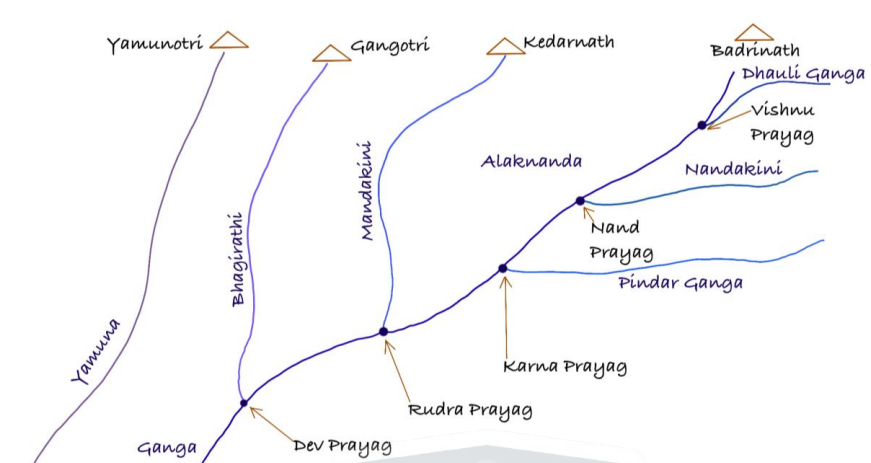
Ganga River System – Key Facts
| Aspect | Details |
|---|---|
| Origin | Bhagirathi (Gangotri Glacier) + Alaknanda (Satopanth Glacier) → Devprayag |
| Length | 2,525 km |
| Drainage | Bay of Bengal |
| Delta | Sundarbans, world’s largest delta |
| Major Tributaries | Yamuna, Ghaghra, Gandak, Kosi, Son |
| Distributaries | Bhagirathi-Hooghly, Padma (Bangladesh) |
| Major Dams | Tehri, Farakka Barrage, Bansagar |
| Basin Area | ~8.6 lakh sq. km (India, Nepal, Tibet, Bangladesh) |
| States Covered | Uttarakhand, UP, Bihar, Jharkhand, West Bengal |
| International | Flows into Bangladesh as Padma, joins Brahmaputra & Meghna |
Mains Key Points
Prelims Strategy Tips
The Ganga River System – Extension in Bangladesh
After entering Bangladesh, the Ganga is renamed the Padma. It merges with the Jamuna (Brahmaputra distributary) and later with Meghna, before forming the Meghna estuary in the Bay of Bengal. This final course creates one of the most fertile and densely populated regions of the world, the Ganga–Brahmaputra–Meghna Delta.
After entering Bangladesh, the Ganga is renamed the Padma. It merges with the Jamuna (Brahmaputra distributary) and later with Meghna, before forming the Meghna estuary in the Bay of Bengal. This final course creates one of the most fertile and densely populated regions of the world, the Ganga–Brahmaputra–Meghna Delta.
Ganga (Padma–Meghna) in Bangladesh
| Aspect | Details |
|---|---|
| Name in Bangladesh | Padma → Meghna |
| Major Confluences | Padma + Jamuna (Brahmaputra distributary); Padma + Meghna |
| Final Course | Meghna estuary, Bay of Bengal |
| Delta | Sundarbans Delta (~80,000 sq km) |
| Major Cities | Rajshahi, Goalundo, Chandpur, Khulna |
| Water Treaty | India-Bangladesh Ganga Water Treaty (1996) |
Mains Key Points
Prelims Strategy Tips
The Ganga River System
The Ganga is India’s most important river system, originating from the Gangotri glacier (Bhagirathi) and flowing southeast for 2,525 km before discharging into the Bay of Bengal. It supports the largest alluvial plain of the world and is culturally revered as ‘Ganga Mata’.
The Ganga is India’s most important river system, originating from the Gangotri glacier (Bhagirathi) and flowing southeast for 2,525 km before discharging into the Bay of Bengal. It supports the largest alluvial plain of the world and is culturally revered as ‘Ganga Mata’.
Ganga River – Key Facts
| Aspect | Details |
|---|---|
| River Name | Ganga |
| Origin | Bhagirathi from Gangotri Glacier at Gaumukh |
| Length | 2,525 km |
| Discharge | Bay of Bengal |
| Major States & Cities | Rishikesh, Haridwar, Kanpur, Varanasi, Patna, Bhagalpur, Kolkata |
| Right Bank Tributaries | Yamuna, Son, Damodar |
| Left Bank Tributaries | Ramganga, Gomati, Ghaghara, Gandak, Kosi, Mahananda |
| Major Dams | Tehri Dam, Narora Barrage, Lav-Kush Barrage, Farakka Barrage |
Mains Key Points
Prelims Strategy Tips
The Yamuna River System
The Yamuna is the westernmost and longest tributary of the Ganga. Originating from the Yamunotri glacier in the Banderpunch range, it flows for 1,376 km before joining the Ganga at Prayagraj. It is culturally revered and economically vital, supporting several major cities along its course.
The Yamuna is the westernmost and longest tributary of the Ganga. Originating from the Yamunotri glacier in the Banderpunch range, it flows for 1,376 km before joining the Ganga at Prayagraj. It is culturally revered and economically vital, supporting several major cities along its course.
Yamuna River – Key Facts
| Aspect | Details |
|---|---|
| River Name | Yamuna |
| Origin | Yamunotri Glacier, Banderpunch Range |
| Length | 1,376 km |
| Discharge | Into the Ganga at Prayagraj |
| Major States & Cities | Delhi, Agra, Mathura, Etawah, Prayagraj |
| Right Bank Tributaries | Chambal, Sind, Betwa, Ken |
| Left Bank Tributaries | Hindon, Rind, Sengar, Varuna |
| Major Dams/Barrages | Asan Barrage, Hathnikund Barrage, Wazirabad Barrage, Okhla Barrage |
Mains Key Points
Prelims Strategy Tips
The Chambal River System
The Chambal is a major right-bank tributary of the Yamuna, originating from the Janapao Hills in the Malwa Plateau. Known for its badland topography, the river flows through Madhya Pradesh and Rajasthan before joining the Yamuna in Uttar Pradesh. It is significant for irrigation, hydro-power, and unique ravine landscapes.
The Chambal is a major right-bank tributary of the Yamuna, originating from the Janapao Hills in the Malwa Plateau. Known for its badland topography, the river flows through Madhya Pradesh and Rajasthan before joining the Yamuna in Uttar Pradesh. It is significant for irrigation, hydro-power, and unique ravine landscapes.
Chambal River – Key Facts
| Aspect | Details |
|---|---|
| River Name | Chambal |
| Origin | Janapao Hills, Malwa Plateau, Madhya Pradesh |
| Length | 965 km |
| Discharge | Joins Yamuna in Etawah, Uttar Pradesh |
| Right Bank Tributaries | Parbati, Kali Sindh, Shipra |
| Left Bank Tributaries | Banas, Mej |
| Major Dams/Projects | Gandhisagar Dam, Chambal Valley Project (Rana Pratap Sagar, Jawahar Sagar) |
| Special Features | Chambal Ravines, National Chambal Sanctuary |
Mains Key Points
Prelims Strategy Tips
The Sind River System
The Sind River is an important right-bank tributary of the Yamuna, originating from the Vidisha Plateau in Madhya Pradesh. Flowing for about 470 km, it plays a vital role in irrigation, agriculture, and regional water supply. The river also supports hydropower and local ecosystems through projects like the Manikheda Dam.
The Sind River is an important right-bank tributary of the Yamuna, originating from the Vidisha Plateau in Madhya Pradesh. Flowing for about 470 km, it plays a vital role in irrigation, agriculture, and regional water supply. The river also supports hydropower and local ecosystems through projects like the Manikheda Dam.
Sind River – Key Facts
| Aspect | Details |
|---|---|
| River Name | Sind |
| Origin | Vidisha Plateau, Madhya Pradesh |
| Length | 470 km |
| Discharge | Joins Yamuna near Etawah, Uttar Pradesh |
| Right Bank Tributary | Pahuj |
| Left Bank Tributary | Kwari |
| Major Dam/Project | Manikheda Dam (Shivpuri, MP) |
| Importance | Irrigation, agriculture support, hydropower, water supply |
Mains Key Points
Prelims Strategy Tips
The Betwa and Ken River Systems
The Betwa and Ken rivers are significant right-bank tributaries of the Yamuna, flowing through Madhya Pradesh and Uttar Pradesh. Both rivers support irrigation, agriculture, and hydropower projects in the drought-prone Bundelkhand region, making them vital for water security and development.
The Betwa and Ken rivers are significant right-bank tributaries of the Yamuna, flowing through Madhya Pradesh and Uttar Pradesh. Both rivers support irrigation, agriculture, and hydropower projects in the drought-prone Bundelkhand region, making them vital for water security and development.
Betwa and Ken River Systems – Key Facts
| Aspect | Betwa River | Ken River |
|---|---|---|
| Origin | Vindhyan ranges near Bhopal (Raisen district, MP) | Baner Range, near Jabalpur (MP) |
| Length | 590 km | 427 km |
| Discharge | Joins Yamuna near Hamirpur (UP) | Joins Yamuna near Chila (UP) |
| Right Bank Tributaries | Bina, Dhasaan, Jamni | — |
| Left Bank Tributaries | — | Sonar, Kopra, Siameri, Kutni |
| Major Dams/Projects | Rajghat Dam; part of Ken-Betwa Link Project | Ken-Betwa Link Project |
| States & Cities | Flows through Vidisha, Sanchi, Orchha | Flows through Panna, Chhatarpur |
Mains Key Points
Prelims Strategy Tips
The Son and Damodar River Systems
The Son and Damodar rivers are important tributaries of the Ganga system, playing key roles in irrigation, hydropower, and flood control. While Son flows as a major right-bank tributary of Ganga, Damodar flows into the Hooghly and has been historically known as the 'Sorrow of Bengal' due to devastating floods.
The Son and Damodar rivers are important tributaries of the Ganga system, playing key roles in irrigation, hydropower, and flood control. While Son flows as a major right-bank tributary of Ganga, Damodar flows into the Hooghly and has been historically known as the 'Sorrow of Bengal' due to devastating floods.
Son and Damodar River Systems – Key Facts
| Aspect | Son River | Damodar River |
|---|---|---|
| Origin | Amarkantak Plateau (MP) | Sonajhuria Falls, Chotanagpur Plateau (Bihar) |
| Length | 784 km | 592 km |
| Discharge | Joins Ganga at Arrah, Bihar | Joins Hooghly River (West Bengal) |
| Right Bank Tributaries | Banas, Rihand, North Koel | Sali |
| Left Bank Tributaries | Ghaghar, Johilla | Barakar, Konar, Jamunia |
| Major Projects | Bansagar Dam, Indrapuri Barrage | Damodar Valley Corporation (DVC) |
| Nicknames/Features | Major right-bank tributary of Ganga | ‘Sorrow of Bengal’ (historic floods) |
Mains Key Points
Prelims Strategy Tips
The Ramganga and Ghaghara River Systems
The Ramganga and Ghaghara are important left-bank tributaries of the Ganga, contributing significantly to the river's flow in the northern plains. While Ramganga originates in the Garhwal hills, Ghaghara rises near Mansarovar and carries a large volume of water into the Ganga.
The Ramganga and Ghaghara are important left-bank tributaries of the Ganga, contributing significantly to the river's flow in the northern plains. While Ramganga originates in the Garhwal hills, Ghaghara rises near Mansarovar and carries a large volume of water into the Ganga.
Ramganga vs Ghaghara – Key Facts
| Aspect | Ramganga River | Ghaghara River |
|---|---|---|
| Origin | Garhwal hills near Kalagarh | Mapchachungo Glacier near Mansarovar |
| Length | 596 km | 1080 km |
| Discharge | Joins Ganga near Kannauj | Joins Ganga at Chhapra (Bihar) |
| Major Tributaries | Khoh, Gangan, Aril, Kosi, Deoha | Seti, Sarda, Bheri, Sarju, Rapti |
| Importance | Supports irrigation in western UP | Flood-prone, enriches soil in Bihar and UP |
| Known as | Ramganga | Karnali (Nepal), Ghaghara (India) |
Mains Key Points
Prelims Strategy Tips
The Saryu and Gandak River Systems
Saryu and Gandak are significant Himalayan tributaries contributing to the Ganga system. While Saryu joins the Ghaghara, Gandak directly flows into the Ganga. Both rivers are vital for irrigation, culture, and regional agriculture.
Saryu and Gandak are significant Himalayan tributaries contributing to the Ganga system. While Saryu joins the Ghaghara, Gandak directly flows into the Ganga. Both rivers are vital for irrigation, culture, and regional agriculture.
Comparison of Saryu and Gandak Rivers
| Aspect | Saryu River | Gandak River |
|---|---|---|
| Origin | Milan Glacier (Nepal Himalayas) | Kaligandak & Trishul Ganga (Nepal Himalayas) |
| Length | 350 km | 814 km |
| Known as | Goriganga, Kali (Indo-Nepal Border), Chauka (Plains) | Narayani in Nepal |
| Discharge | Joins Ghaghara | Joins Ganga |
| Tributaries | — | Right: Badigad; Left: Budhi Gandak, Trishuli, Madi, Seti |
| Importance | Boundary demarcation & irrigation in UP | Fertile basin in Bihar; irrigation via Gandak Barrage |
Mains Key Points
Prelims Strategy Tips
The Burhi Gandak and Kosi River Systems
Burhi Gandak and Kosi are important tributaries of the Ganga system in Bihar. While Burhi Gandak is a relatively smaller river rising from the Sumesar hills, Kosi is a powerful trans-boundary river notorious for floods and channel shifts, earning the title 'Sorrow of Bihar'.
Burhi Gandak and Kosi are important tributaries of the Ganga system in Bihar. While Burhi Gandak is a relatively smaller river rising from the Sumesar hills, Kosi is a powerful trans-boundary river notorious for floods and channel shifts, earning the title 'Sorrow of Bihar'.
Comparison of Burhi Gandak and Kosi Rivers
| Aspect | Burhi Gandak | Kosi |
|---|---|---|
| Origin | Sumesar Hills near Indo-Nepal Border | Arun River, north of Mount Everest (Tibet) |
| Length | — | 720–820 km approx. |
| Course | Flows southeast, joins Ganga near Monghyr (Munger) | Joins Sun Kosi & Tamur Kosi at Triveni to form Sapt Kosi; joins Ganga near Kursela |
| States & Cities | Bihar (Munger region) | Bihar: Saharsa, Purnea, Khagaria, Madhubani, Muzaffarpur, Darbhanga |
| Tributaries | — | Sun Kosi, Tamur Kosi (major headstreams) |
| Importance | Local irrigation and floodplain fertility | Called 'Sorrow of Bihar'; flood control via Hanuman Nagar Barrage |
Mains Key Points
Prelims Strategy Tips
The Brahmaputra River System
The Brahmaputra is one of the world’s largest rivers, originating in the Chemayungdung glacier of the Kailash Range. Known as Tsangpo in Tibet, Dihang in Arunachal Pradesh, and Jamuna in Bangladesh, it plays a vital role in the hydrology, culture, and economy of South Asia.
The Brahmaputra is one of the world’s largest rivers, originating in the Chemayungdung glacier of the Kailash Range. Known as Tsangpo in Tibet, Dihang in Arunachal Pradesh, and Jamuna in Bangladesh, it plays a vital role in the hydrology, culture, and economy of South Asia.
Brahmaputra River System – Quick Facts
| Aspect | Details |
|---|---|
| Origin | Chemayungdung Glacier, Kailash Range (Tibet) |
| Name Variations | Tsangpo (Tibet), Siang/Dihang (India), Jamuna (Bangladesh) |
| Length | 2,900 km approx. |
| Major Left Tributaries | Dibang, Lohit, Buri Dihing, Noa Dihing, Dhansiri, Dibru, Dikhu, Kalang |
| Major Right Tributaries | Kameng, Subansiri, Manas, Sankosh |
| Notable Feature | World’s largest riverine island – Majuli |
| Confluence | Merges with Padma (Ganga) and Meghna in Bangladesh before draining into Bay of Bengal |
Mains Key Points
Prelims Strategy Tips
Majuli Island
Majuli is the largest river island in the world, located on the Brahmaputra River in Assam. Known for its unique cultural heritage and environmental significance, Majuli is a vital hub of Assamese Neo-Vaishnavite culture founded by Srimanta Sankardev.
Majuli is the largest river island in the world, located on the Brahmaputra River in Assam. Known for its unique cultural heritage and environmental significance, Majuli is a vital hub of Assamese Neo-Vaishnavite culture founded by Srimanta Sankardev.
Majuli Island – Quick Facts
| Aspect | Details |
|---|---|
| Location | On Brahmaputra River, Assam |
| Global Significance | World’s largest river island |
| Cultural Hub | Neo-Vaishnavite Satras by Srimanta Sankardev |
| Ecological Status | Frequent floods and erosion, UNESCO tentative site |
| District Status | Declared India’s first island district (2016) |
| Unique Feature | Surrounded by small islets called 'Chaporis' |
Mains Key Points
Prelims Strategy Tips
Peninsular Drainage System
Peninsular India, forming an irregular triangular plateau, is drained by ancient rivers older than the Himalayan ones. These rivers display maturity with broad, shallow valleys, fixed courses, and distinct delta or estuary formations.
Peninsular India, forming an irregular triangular plateau, is drained by ancient rivers older than the Himalayan ones. These rivers display maturity with broad, shallow valleys, fixed courses, and distinct delta or estuary formations.
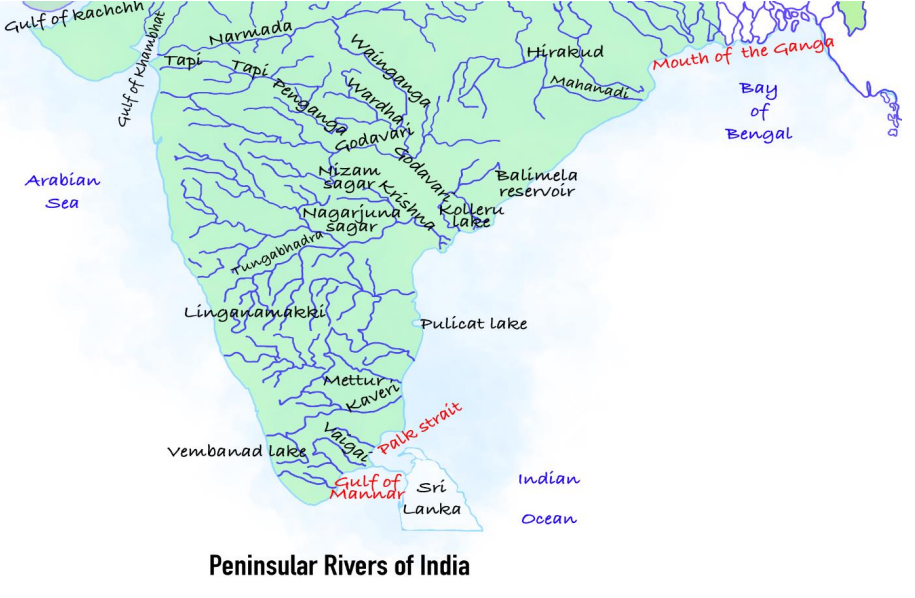
Peninsular Drainage System – Key Features
| Aspect | Details |
|---|---|
| Age | Older than Himalayan rivers |
| Course | Fixed and stable |
| Flow | Mostly non-perennial |
| Meanders | Absent due to stable landforms |
| Sediment Load | Low carrying capacity |
| Delta Formation | East-flowing rivers (Godavari, Cauvery) |
| Estuary Formation | West-flowing rivers (Narmada, Tapti) |
Mains Key Points
Prelims Strategy Tips
Evolution of Peninsular Rivers
The present drainage system of Peninsular India was shaped by three major geological events: subsidence of the western peninsula, rise of the Himalayas with rift valley formation, and tilting of the peninsular block towards the southeast. These events directed most rivers eastward into the Bay of Bengal, with Narmada and Tapti as notable west-flowing exceptions.
The present drainage system of Peninsular India was shaped by three major geological events: subsidence of the western peninsula, rise of the Himalayas with rift valley formation, and tilting of the peninsular block towards the southeast. These events directed most rivers eastward into the Bay of Bengal, with Narmada and Tapti as notable west-flowing exceptions.
Evolution of Peninsular Rivers – Geological Factors
| Event | Impact on Rivers |
|---|---|
| Subsidence of western peninsula | Submergence below sea level (Tertiary period) |
| Rise of Himalayas + subsidence of northern peninsula | Formation of rift valleys; Narmada & Tapti flow through them |
| Tilting of peninsular block (NW to SE) | Directed most rivers eastward towards Bay of Bengal |
Mains Key Points
Prelims Strategy Tips
East Flowing Rivers – Mahanadi and Godavari River Systems
The Mahanadi and Godavari are two significant east-flowing rivers of Peninsular India, draining into the Bay of Bengal. While the Mahanadi flows through Chhattisgarh and Odisha forming fertile deltas, the Godavari, also called Dakshin Ganga, is the largest peninsular river with an extensive drainage basin across multiple states.
The Mahanadi and Godavari are two significant east-flowing rivers of Peninsular India, draining into the Bay of Bengal. While the Mahanadi flows through Chhattisgarh and Odisha forming fertile deltas, the Godavari, also called Dakshin Ganga, is the largest peninsular river with an extensive drainage basin across multiple states.
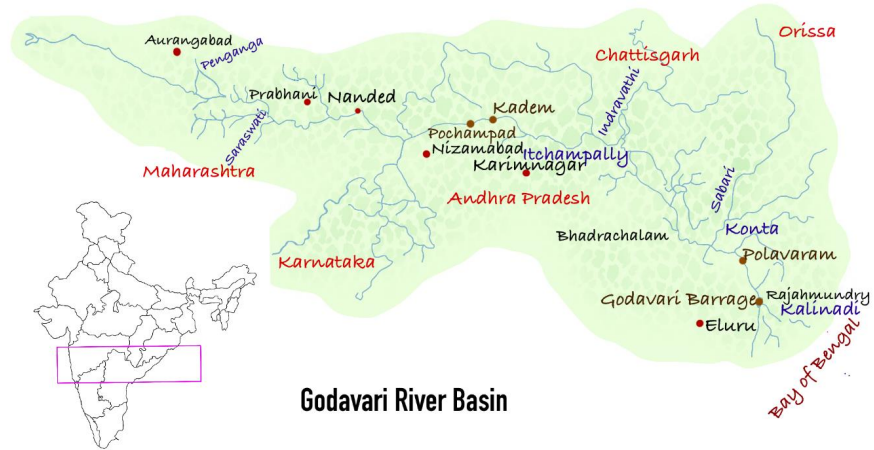
Comparison of Mahanadi and Godavari River Systems
| Feature | Mahanadi | Godavari |
|---|---|---|
| Origin | Sihawa, Dandakaranya plateau (Chhattisgarh) | Trimbaka plateau, Nashik (Maharashtra) |
| Length | 900 km | 1465 km |
| Discharge | Bay of Bengal | Bay of Bengal |
| Drainage Basin | 53% in MP & Chhattisgarh; 47% in Odisha | 49% Maharashtra; 21% MP & Chhattisgarh; 24% Andhra Pradesh; rest Odisha |
| Major Cities | Raipur, Bilaspur, Cuttack, Sambalpur | Trimbakeshwar, Nashik, Paithan, Rajahmundry |
| Tributaries | Ong, Jonk, Telen, Ib, Mand, Hasdo | Manjra, Penganga, Wardha, Wainganga, Indravati, Sabri, Pranhita |
| Major Dams | Hirakud Dam | Sri Ram Sagar Dam |
| Special Feature | Forms fertile delta in Odisha | Splits into Gautami & Vashistha branches, forming a large delta |
Mains Key Points
Prelims Strategy Tips
Krishna River System
The Krishna River, the second-largest east-flowing river of Peninsular India, rises from Mahabaleshwar in the Western Ghats and flows eastward into the Bay of Bengal. With an extensive basin across Maharashtra, Karnataka, and Andhra Pradesh, it supports major irrigation projects and forms a vital part of peninsular water resources.
The Krishna River, the second-largest east-flowing river of Peninsular India, rises from Mahabaleshwar in the Western Ghats and flows eastward into the Bay of Bengal. With an extensive basin across Maharashtra, Karnataka, and Andhra Pradesh, it supports major irrigation projects and forms a vital part of peninsular water resources.
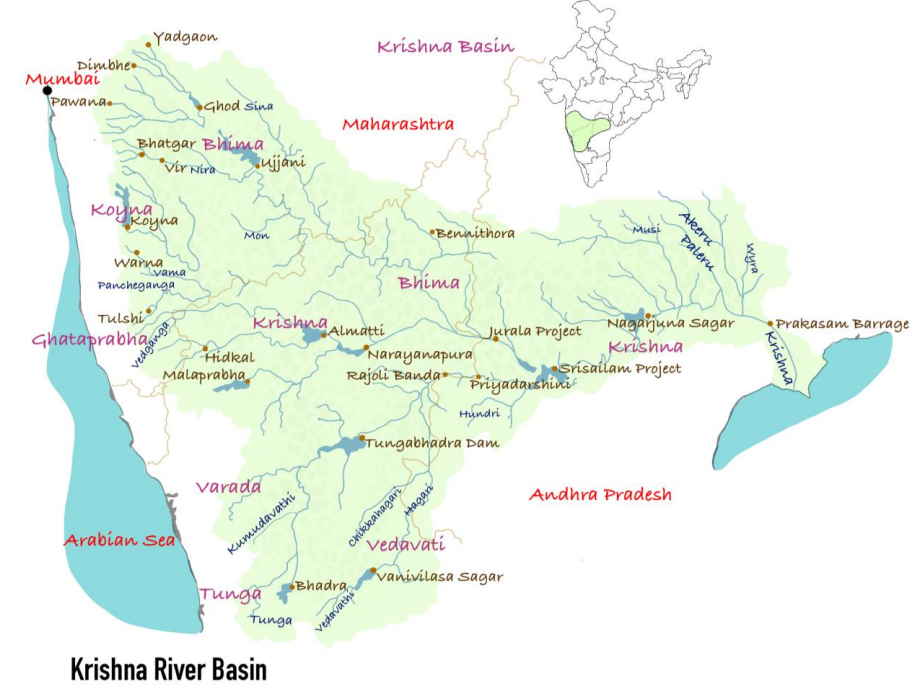
Key Features of Krishna River System
| Aspect | Details |
|---|---|
| River Name | Krishna |
| Origin | Mahabaleshwar, Western Ghats |
| Length | 1290 km |
| Discharge | Bay of Bengal |
| Basin Area | 27% Maharashtra, 29% Andhra Pradesh, 44% Karnataka |
| Major Cities | Mahabaleshwar, Srisailam, Vijayawada, Amaravati |
| Tributaries | Kudali Venna, Koyna, Panchganga, Dudhaganga, Ghataprabha, Malaprabha, Tungabhadra, Bhima, Musi, etc. |
| Major Dams | Prakasam Barrage, Tungabhadra Dam, Nagarjuna Sagar Dam, Bhima Dam, Srisailam Dam |
Mains Key Points
Prelims Strategy Tips
Cauvery River System
The Cauvery River, rising from Tala Cauvery in the Brahmagiri hills of Karnataka, is a significant east-flowing peninsular river. Flowing through Karnataka and Tamil Nadu, it is vital for irrigation, hydro-power, and cultural heritage. It forms the famous Sivasamudram Falls and the riverine island of Srirangam before discharging into the Bay of Bengal.
The Cauvery River, rising from Tala Cauvery in the Brahmagiri hills of Karnataka, is a significant east-flowing peninsular river. Flowing through Karnataka and Tamil Nadu, it is vital for irrigation, hydro-power, and cultural heritage. It forms the famous Sivasamudram Falls and the riverine island of Srirangam before discharging into the Bay of Bengal.
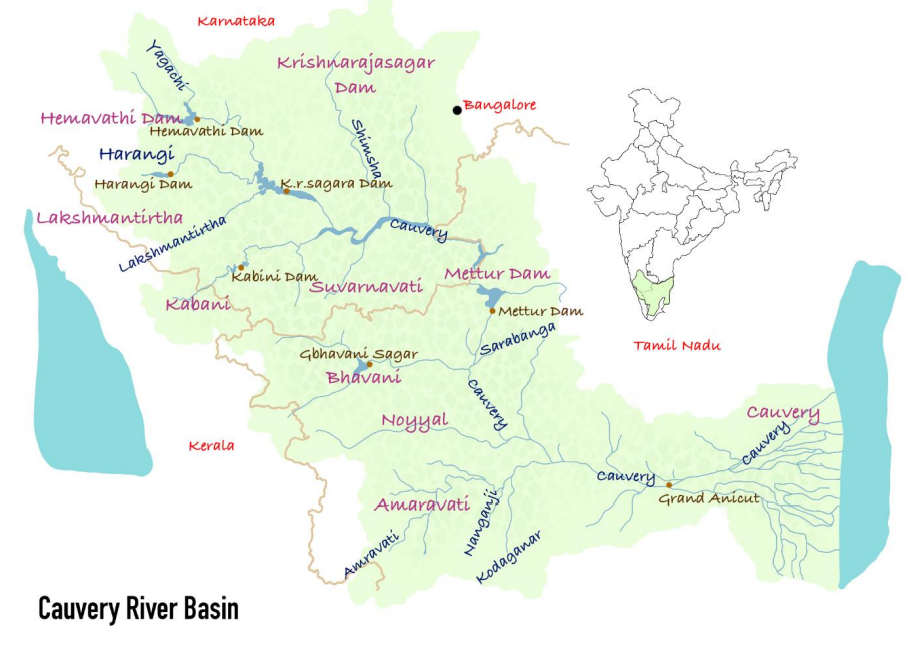
Key Features of Cauvery River System
| Aspect | Details |
|---|---|
| River Name | Cauvery |
| Origin | Tala Cauvery, Brahmagiri hills (Karnataka) |
| Length | 805 km |
| Discharge | Bay of Bengal |
| Basin Area | 3% Kerala, 41% Karnataka, 56% Tamil Nadu |
| Major Cities | Tiruchirappalli, Thanjavur |
| Tributaries | Bhavani, Kabini, Harangi, Hemavati, Shimsha, Arkavati |
| Major Dams | Alalur Dam, Amaravati Dam, Mettur Dam |
| Special Features | Sivasamudram Falls, Riverine island of Srirangam |
Mains Key Points
Prelims Strategy Tips
Other East Flowing Rivers of Peninsular India
Apart from the major east-flowing rivers like Mahanadi, Godavari, Krishna, and Cauvery, several smaller rivers such as Brahmani, Subarnarekha, Baitarani, Budhabalanga, Vamsadhara, and Penneru also drain into the Bay of Bengal, supporting regional agriculture and ecosystems.
Apart from the major east-flowing rivers like Mahanadi, Godavari, Krishna, and Cauvery, several smaller rivers such as Brahmani, Subarnarekha, Baitarani, Budhabalanga, Vamsadhara, and Penneru also drain into the Bay of Bengal, supporting regional agriculture and ecosystems.
Other East Flowing Rivers of Peninsular India
| River | Source | Discharge | States |
|---|---|---|---|
| Brahmani | Confluence of Sankh & South Koel | Bay of Bengal | Odisha |
| Subarnarekha | Piska/Nagri (Rani Chuan), Chota Nagpur Plateau | Bay of Bengal | Jharkhand, West Bengal, Odisha |
| Baitarani | Gonasika, Guptaganga Hills | Bay of Bengal | Odisha |
| Budhabalanga | Similipal Hills | Bay of Bengal | Odisha |
| Vamsadhara | Thuamul Rampur | Bay of Bengal | Odisha, Andhra Pradesh |
| Penneru | Nandi Hills, Karnataka | Bay of Bengal | Karnataka, Andhra Pradesh |
Mains Key Points
Prelims Strategy Tips
West Flowing Rivers – Narmada and Tapti River Systems
Narmada and Tapti are the two major west-flowing rivers of Peninsular India. Both rivers traverse through rift valleys and drain into the Arabian Sea, forming estuaries. Narmada is the largest west-flowing river, while Tapti is considered its ‘twin’.
Narmada and Tapti are the two major west-flowing rivers of Peninsular India. Both rivers traverse through rift valleys and drain into the Arabian Sea, forming estuaries. Narmada is the largest west-flowing river, while Tapti is considered its ‘twin’.
Comparison of Narmada and Tapti River Systems
| Aspect | Narmada | Tapti |
|---|---|---|
| Origin | Amarkantak Plateau | Multai, Betul District (Madhya Pradesh) |
| Length | 1310 km | 724 km |
| Discharge | Arabian Sea (Gulf of Khambhat) | Arabian Sea |
| Course | Flows through rift valley between Vindhyan & Satpura ranges | Flows through rift valley |
| Major Cities | Omkareshwar, Bharuch | Surat |
| Tributaries | Hiran, Orsang, Barna, Tawa, etc. | Vaki, Gomai, Girna, Purna, etc. |
| Major Dams | Sardar Sarovar, Indira Sagar | Ukai Dam, Girna Dam |
| Special Features | Dhuandhar Falls, 27 km estuary | Known as ‘Twin’ of Narmada |
Mains Key Points
Prelims Strategy Tips
Luni River System
The Luni is the largest river system of Rajasthan. Originating near Pushkar, it flows as an ephemeral river through arid regions before ending in the Rann of Kutch. It is formed by the confluence of Saraswati and Sagarmati branches at Govindgarh.
The Luni is the largest river system of Rajasthan. Originating near Pushkar, it flows as an ephemeral river through arid regions before ending in the Rann of Kutch. It is formed by the confluence of Saraswati and Sagarmati branches at Govindgarh.
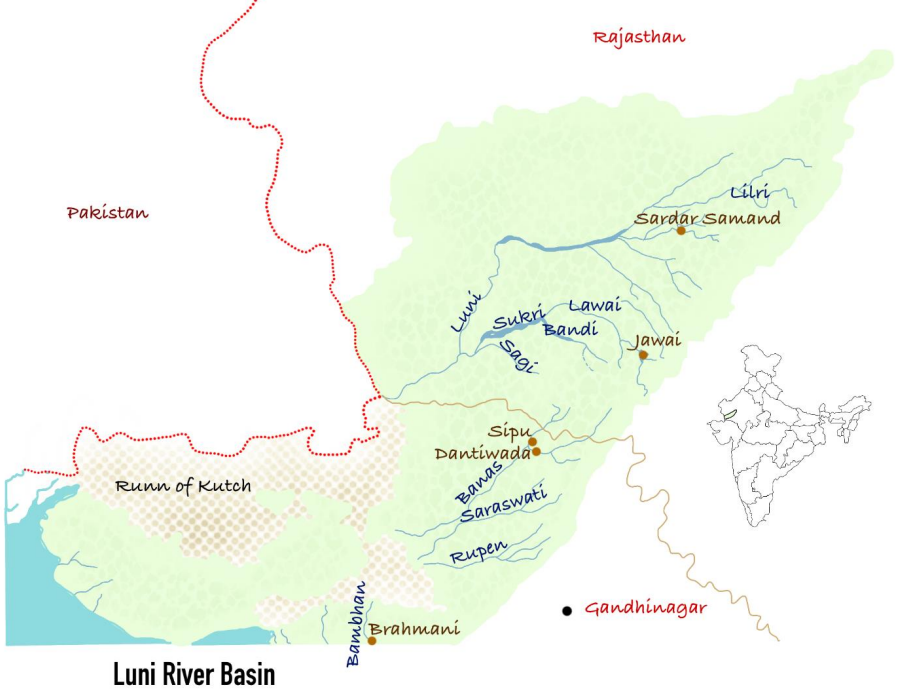
Key Features of Luni River System
| Aspect | Details |
|---|---|
| River Name | Luni |
| Origin | Govindgarh (confluence of Saraswati & Sagarmati near Pushkar) |
| Length | 495 km |
| Discharge | Rann of Kutch |
| Nature | Ephemeral (flows only after rainfall) |
| Tributaries | Jojari, Jawai, Sukri, Guhiya, Bandi |
| Major Dams | Dantiwada Dam, Sipu Dam, Jaswant Sagar Dam |
Mains Key Points
Prelims Strategy Tips
Sabarmati River System
The Sabarmati River, named after the Sabar and Hatmati streams, originates from the Mewar region in the Aravalli range and flows into the Gulf of Khambhat. It is an important river of western India, passing through major cities like Ahmedabad and Gandhinagar.
The Sabarmati River, named after the Sabar and Hatmati streams, originates from the Mewar region in the Aravalli range and flows into the Gulf of Khambhat. It is an important river of western India, passing through major cities like Ahmedabad and Gandhinagar.
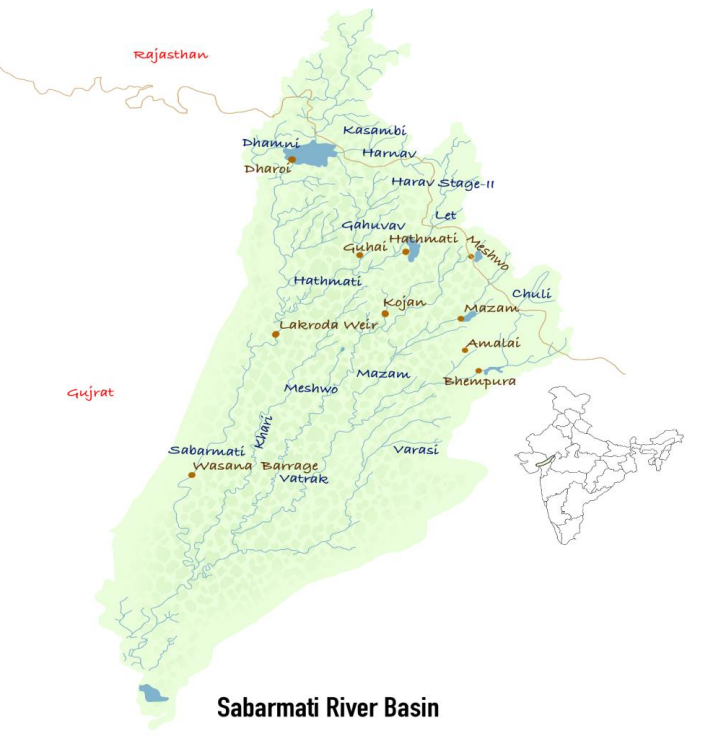
Key Features of Sabarmati River System
| Aspect | Details |
|---|---|
| River Name | Sabarmati |
| Origin | Mewar, Aravalli range |
| Length | 371 km |
| Discharge | Gulf of Khambhat |
| Major Cities | Ahmedabad, Sabarmati, Gandhinagar |
| Tributaries | Sei, Wakal, Harnav, Hathmati, Watrak |
| Major Dams | Hathmati Dam, Harnav Dam, Guhai Dam |
Mains Key Points
Prelims Strategy Tips
Mahi River System and Other West-Flowing Rivers of Western Ghats
The Mahi River, originating from the Vindhyas, uniquely crosses the Tropic of Cancer twice before draining into the Gulf of Khambhat. Along with it, several short west-flowing rivers from the Western Ghats such as Kalinadi, Sharavati, Mandovi, Zuari, Bharathapuzha, and Pamba also drain into the Arabian Sea. These rivers, despite carrying significant water resources, do not form deltas due to steep slopes, short courses, and strong tidal action.
The Mahi River, originating from the Vindhyas, uniquely crosses the Tropic of Cancer twice before draining into the Gulf of Khambhat. Along with it, several short west-flowing rivers from the Western Ghats such as Kalinadi, Sharavati, Mandovi, Zuari, Bharathapuzha, and Pamba also drain into the Arabian Sea. These rivers, despite carrying significant water resources, do not form deltas due to steep slopes, short courses, and strong tidal action.
Key Features of Mahi River System
| Aspect | Details |
|---|---|
| River Name | Mahi |
| Origin | Vindhyas, Dhar district (Madhya Pradesh) |
| Length | 580 km |
| Discharge | Gulf of Khambhat |
| Unique Feature | Crosses Tropic of Cancer twice |
| Tributaries | Som, Anas, Panam |
| Major Dams | Bajaj Sagar Dam, Kadana Dam |
Other West-Flowing Rivers of Western Ghats
| River | Origin | Discharge | Special Feature |
|---|---|---|---|
| Kalinadi | Belgaum district, Karnataka | Karwar Bay | Short west-flowing river |
| Sharavati | Shimoga district, Karnataka | Arabian Sea | Forms Jog Falls (highest waterfall in India) |
| Mandovi | Goa | Arabian Sea | Important Goan river |
| Zuari | Goa | Arabian Sea | Flows through southern Goa |
| Bharathapuzha | Near Annamalai Hills, Kerala | Arabian Sea | Major Kerala river |
| Pamba | Western Ghats, Kerala | Arabian Sea | Sacred river of Kerala |
Mains Key Points
Prelims Strategy Tips
Comparative Difference Between Himalayan Rivers and Peninsular Rivers
The Himalayan rivers and Peninsular rivers differ in origin, basin size, drainage type, flow nature, landforms, and maturity. While Himalayan rivers are perennial, large, and youthful forming big deltas, Peninsular rivers are mostly seasonal, smaller, mature, and form both deltas (east-flowing) and estuaries (west-flowing).
The Himalayan rivers and Peninsular rivers differ in origin, basin size, drainage type, flow nature, landforms, and maturity. While Himalayan rivers are perennial, large, and youthful forming big deltas, Peninsular rivers are mostly seasonal, smaller, mature, and form both deltas (east-flowing) and estuaries (west-flowing).
Comparison: Himalayan Rivers vs Peninsular Rivers
| Feature | Himalayan River System | Peninsular River System |
|---|---|---|
| Origin | Originate from the Himalayan ranges | Originate from the Peninsular Plateau |
| Size of Basins | Large basins & catchment areas (e.g., Indus, Ganga, Brahmaputra) | Small basins & catchment areas (e.g., Mahanadi, Godavari, Krishna) |
| Type of Drainage System | Flow through deep 'I'-shaped valleys/gorges, antecedent drainage | Flow in shallow graded valleys, consequent drainage |
| Type of River System | Perennial – fed by monsoon + snowmelt | Seasonal/non-perennial – fed by rainfall only |
| Flow Across Gradient | Flow through young fold mountains; form meanders in plains | Flow across old plateaus; straight courses, little scope for meanders |
| Landforms at Mouth | Form big deltas (e.g., Ganga-Brahmaputra delta – world’s largest) | East-flowing rivers form deltas (Mahanadi, Godavari, Krishna); West-flowing rivers form estuaries (Narmada, Tapti) |
Mains Key Points
Prelims Strategy Tips
Rivers in News
Several Indian rivers have been in recent news due to infrastructure projects, environmental concerns, cultural events, and river revival initiatives. Key rivers include Sabarmati, Narmada, Bedti-Varada, Pranhita, and Sukapaika.
Several Indian rivers have been in recent news due to infrastructure projects, environmental concerns, cultural events, and river revival initiatives. Key rivers include Sabarmati, Narmada, Bedti-Varada, Pranhita, and Sukapaika.
Rivers in Recent News
| River | News/Event | Location | Key Facts |
|---|---|---|---|
| Sabarmati | Inauguration of Atal Bridge | Ahmedabad, Gujarat | 300m bridge, LED lights, steel pipes, cyclists allowed |
| Narmada | Inauguration of Kachchh Branch Canal (Sardar Sarovar Project) | Kachchh, Gujarat | 357 km canal, irrigation + drinking water to 948 villages & 10 towns |
| Bedti & Varada | Opposition to river linking project | Karnataka | Bedti → Arabian Sea; Varada → Tungabhadra → Krishna → Bay of Bengal |
| Pranhita | Pranahita Pushkaralu festival | Telangana | Left-bank tributary of Godavari |
| Sukapaika | NGT ordered revival of river | Cuttack, Odisha | Branch of Mahanadi |
Mains Key Points
Prelims Strategy Tips
Chapter Complete!
Ready to move to the next chapter?
